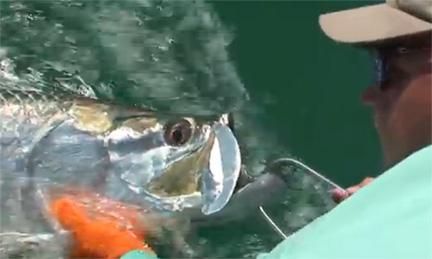Sweat beaded down my arms and dripped wildly off my fingers. The warm breeze was cooling me while I watched the mullet dance under my float. The tide was running quick at the pass by Seven-Mile Bridge and it seemed like hours since the first hook up. Even my shirt was starting to get wet and stuck to my skin but on a hot day that’s what you expect. Yet, my eyes would never leave contact with the float. “Nervous bait, nervous bait”, yelled the Captain. One of the most unique things you’ll ever see when fishing big bait for big fish. You can imagine how an eight-inch fish would react when a 140 lb monster fish shows up beside him. The two-inch float was sitting on the water and with a three-foot lead, this mullet was flipping out of the water and back in, and then my heart stopped as explosion of water that resembled a stick of dynamite, just went off. The tarpon hit its target and the hook set was on. Once, twice, “Hit em again,” the Captain yelled, and of course I set the hook another time as the line kept sizzling off my Okuma level wind. These prehistoric gamesters have a cinder block hard jaw and hard hook sets are a must.
Tailing leaping, head wagging, jumping, diving and runs so fast it looked like the burn-off from a dragster. This “Silver King”, exploded across the water again and again as more line left my reel. We couldn’t turn him back; he was definitely heading out to the blue water of the Atlantic. We pulled anchor and chased this fish to gain line. Talk about a confidence builder when you start gaining line on the reel. I wasn’t too worried about the tough Power Pro line; I was just worried about having the hook pop out on a quick turn or on another jump. A half hour had passed and we were within range to see the shadow 60 yards from the boat. The Captain shut off his engine and now it was up to me to tire him out and bring him close enough to grab the 80 lb leader.
I was finally winning the battle as this giant was near, and what a fish! The one-hour battle was short by comparison to other battles I’d had the month before in Boca Grande, on the Gulf side. Finally we were able to pull this giant along side the boat, take the picture, release and get ready for another bout. Well, that’s after a little cheer, a cold one from the cooler and time to loosen up my arms to fight another one.
My favorite Keys are the Bridges and cuts around Islamorada and Marathon, which offer some of the best fishing for tarpon in the State. Bridges are an important part of Florida Keys history, and continue to be a favorite historic attraction to the area. The best known of all Keys bridges connects Marathon to Little Duck Key and is found between Mile Marker 40 and 47. This bridge is indeed “an integral part of a massive ribbon of steel and concrete that forever changed the history of the Florida Keys.” An engineering marvel, built for train travel in 1912, the original Seven Mile Bridge opened to automobile traffic in 1938. In 1980 the old bridge was designated as an historic monument and still stands, running parallel to its modern contemporary. Today it holds the proud title of being known as the world’s longest fishing pier.
Here in the Keys, the conditions were perfect; light wind, beautiful blue-green, gin clear water and probably the best spot to fly fish for these giants. It’s here between the channels that the flats offer beautiful sand holes that fly anglers enjoy staking off at. What that means is that the skiff is set like anchoring using the push pole with the bow facing the sand holes at the distance the angler can cast his line. They would set the boat up next to a tarpon highway that ran over a white sand bottom so that the fish could be more easily spotted. These highways are usually next to a flat, which acts as a funnel. This is very exciting because it really is like fishing and hunting at the same time. The guide stands on the poling platform sighting fish that may come into range and as for the angler, he stands with fly line out on the deck and fly in hand to make the one false cast and fire! Let me tell you, they say in the Keys, the tarpon travel south to north. When you are standing staked facing south and a pod of giant tarpon over the 100 lb class come by the boat from the north, unnoticed, until they are a few feet from the boat, “WOW and I mean WOW!”
Tarpon boasting the title of “silver king” can be caught in the Florida Keys year-round, but they are usually smaller. Depending on the warming trends, the big boys show up in early March and stay through July. Where these migrating schools arrive from, and where they go and when they leave the Keys is the subject of much debate among guides, anglers, and scientists. Everyone is just happy that they visit.
There are of course a couple of other hot spots that produce a lot of fish, and big fish at that. Both are located on the Gulf side of Florida, and both are well known for big fish. Boca Grande promotes the title of Tarpon Capital of the World and Homassasa targets the giants, as Master Angler Billy Pate will attest to. Boca Grande, located on Gasparilla Island, one of the barrier islands in Southwest Florida, hosts the famous “World’s Richest Tarpon Tournament” each July. It’s the ultimate challenge for any angler. The current Florida record is almost 250 pounds.

